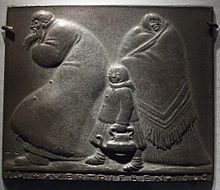Ludwig Gies
[4] At the same time, he attended evening and Sunday classes in modelling and wood carving, which brought Gies into early contact with Richard Riemerschmid and Bruno Paul.
[5] After Ludwig Gies finished at the Municipal Trade School halfway through his training at Winhart's, he attended, up until July 1907, the Royal School of Applied Arts (Königliche Kunstgewerbeschule) in Munich, where he learned chasing, enamelling, carving and ornamental modelling and figurative modelling with Fritz von Miller, Anton Pruska, Maximilian Dasio and Heinrich Waderé.
On 28 August 1917, Bruno Paul, the head of the teaching institute of the Museum of Decorative Arts Berlin, made a business trip to Munich to see various sculptures.
[8] After the takeover of the Nazis, he came under pressure for his loyalty to dissident and Jewish students: in 1937 he was forced out of the Prussian Academy of Arts, and in 1938, dismissed from his teaching position.
[10] Nevertheless, Gies also created for the 1935–1939 extension to the Reichsbank (otherwise known as the Haus am Werderschen Markt), among other things, an Imperial eagle with oak wreath and swastika, made of light metal.
[9] His crucifix in Lübeck Cathedral, originally commissioned by Carl Georg Heise in 1921, the director of St. Anne's Museum, for St. Mary's Church, Lübeck, was already condemned at the time of its creation as "over-Expressionistic" ("überexpressionistisch") and as "culturally Bolshevist" ("kultur-bolschewistisch"), and was later one of the objects of hatred of the Entartete Kunst ("Degenerate Art") exhibition of 1937 in Munich, where it was ostentatiously displayed in the stairwell.
[16][17] Between 1959 and 1962, Gies designed the windows of the choir of Essen Minster and received the Große Kunstpreis des Landes Nordrhein-Westfalen ("Great Art Prize of North Rhine-Westphalia").
His design work for West German churches included altar rails, candlesticks, mosaics, and stained-glass windows.
[22] Gies became known mainly for two sculptures: One was the crucifix in Lübeck Cathedral (1922), a larger than life-size woodcarving "strongly reminiscent of medieval devotional figures in distorted anguish",[23] which was held up as a typical work of degenerate art; its head having been chopped off and plunged in the Trave river.
[25] His successor in his teaching was Hanskarl Burgeff, whose students Agatha Kill, Lucia Hardegen and Hanspeter Dünwald are active in the third generation of the school.


